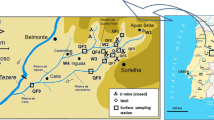Abstract.
A γ-radiation dose rate is defined for the Kara-Balty Industrial Complex, which is located in the Kyrgyz Republic (formerly part of the Soviet Republic). The increased γ-radiation doses are being monitored at tailings areas and at the industrial platform. The γ-radiation dose rate does not exceed background valued in the designated protective (buffer) areas or in the inhabited zones nearby.
We studied the concentration, isotopic composition and spatial distribution of uranium and the concentration and spatial distribution of 226Ra, sulfate and nitrates in the ground water of the region. The central area of intensive ground water contamination by uranium lies within the eastern part of the village of Alexeevka and the western part of the town of Kara-Balty, but neither the concentrations of uranium nor 226Ra exceed the legal limits. The locations where sulfate and nitrate exceed the legal limits and the sources of contamination are defined too.
Similar content being viewed by others
Author information
Authors and Affiliations
Rights and permissions
About this article
Cite this article
Chalov, P., Nifadiev, V. & Vasiliev, I. Evaluating the Environmental Effects of Uranium Production at the Kara-Balty Mining Complex. Mine Water and the Environment 20, 153–157 (2001). https://doi.org/10.1007/s10230-001-8100-5
Issue Date:
DOI: https://doi.org/10.1007/s10230-001-8100-5




